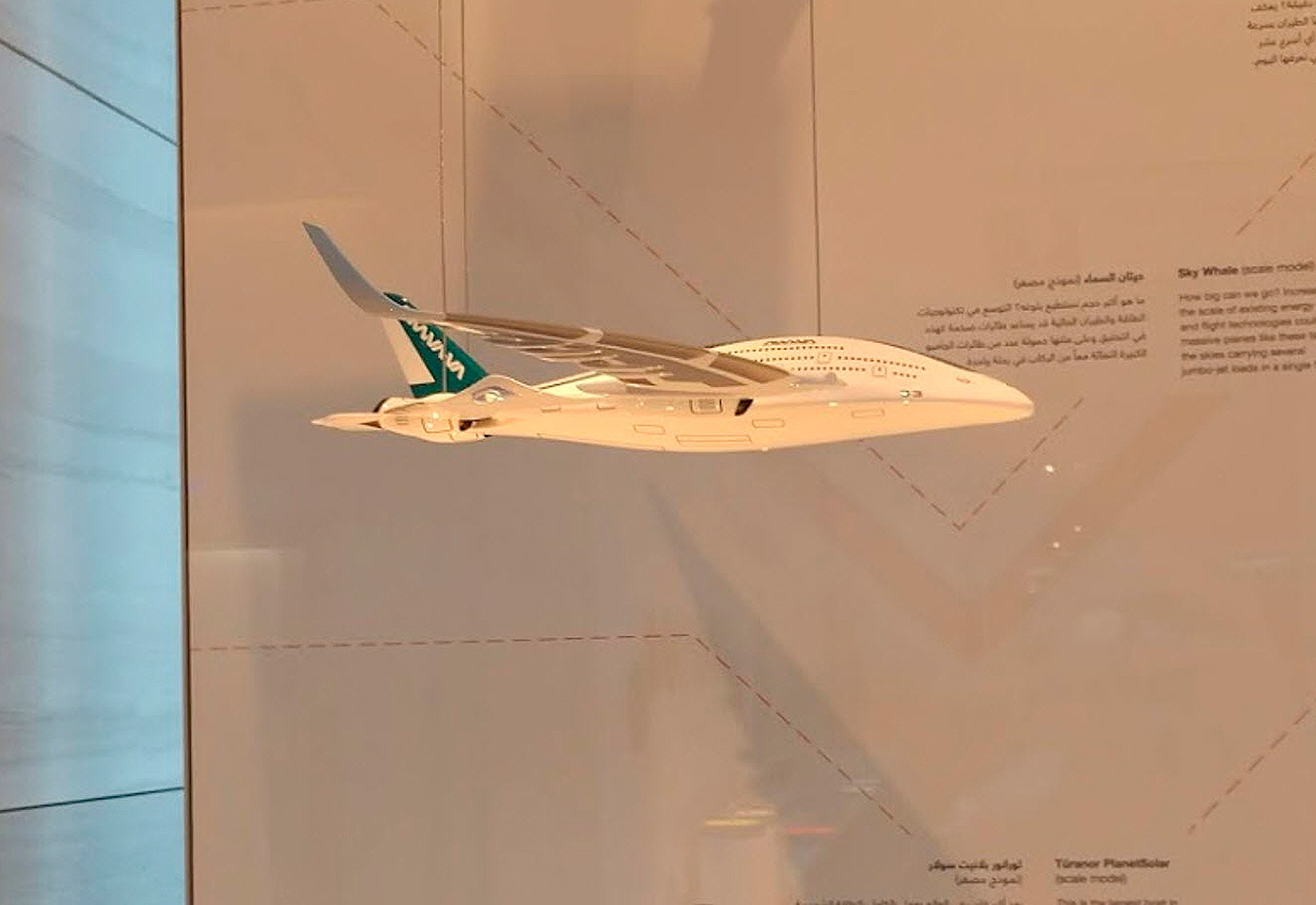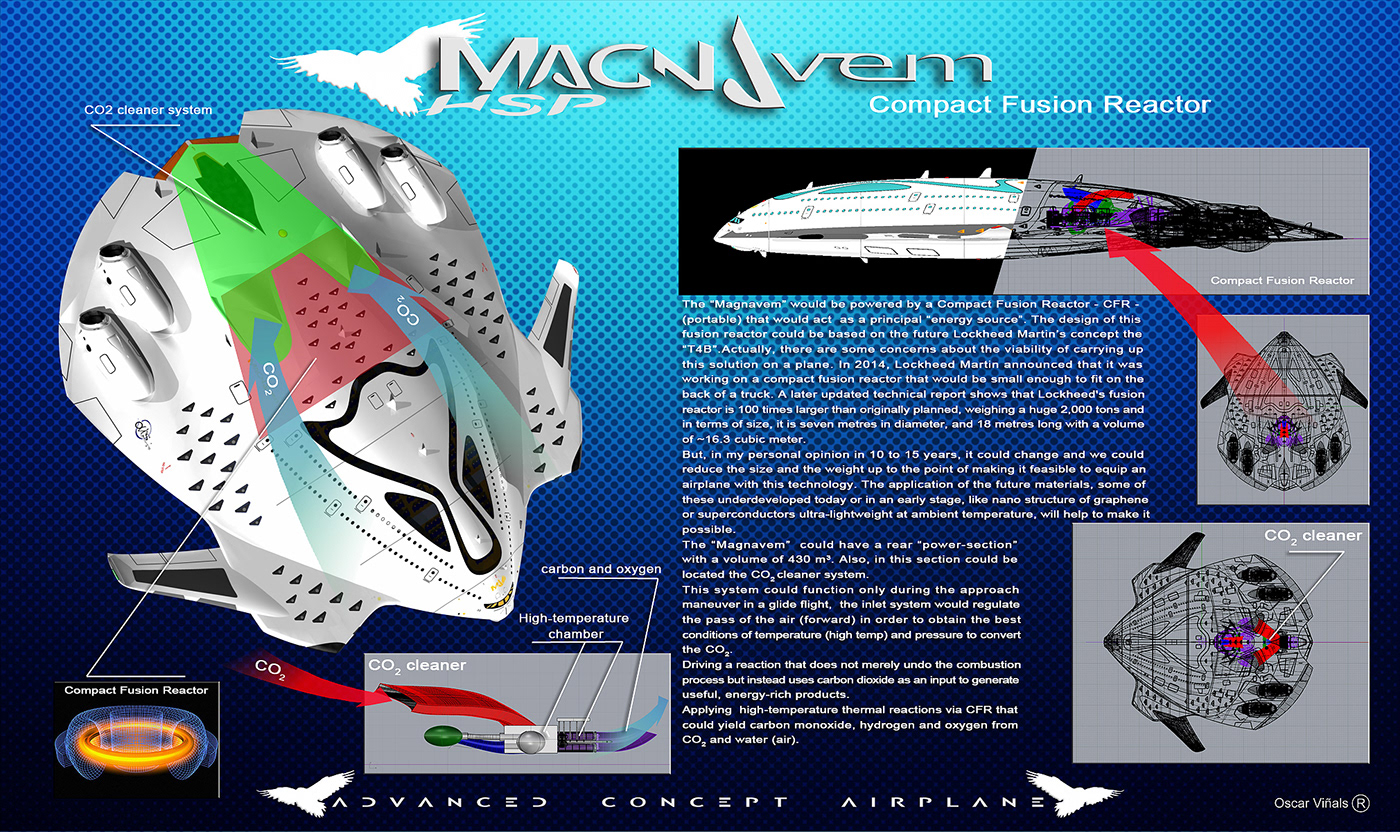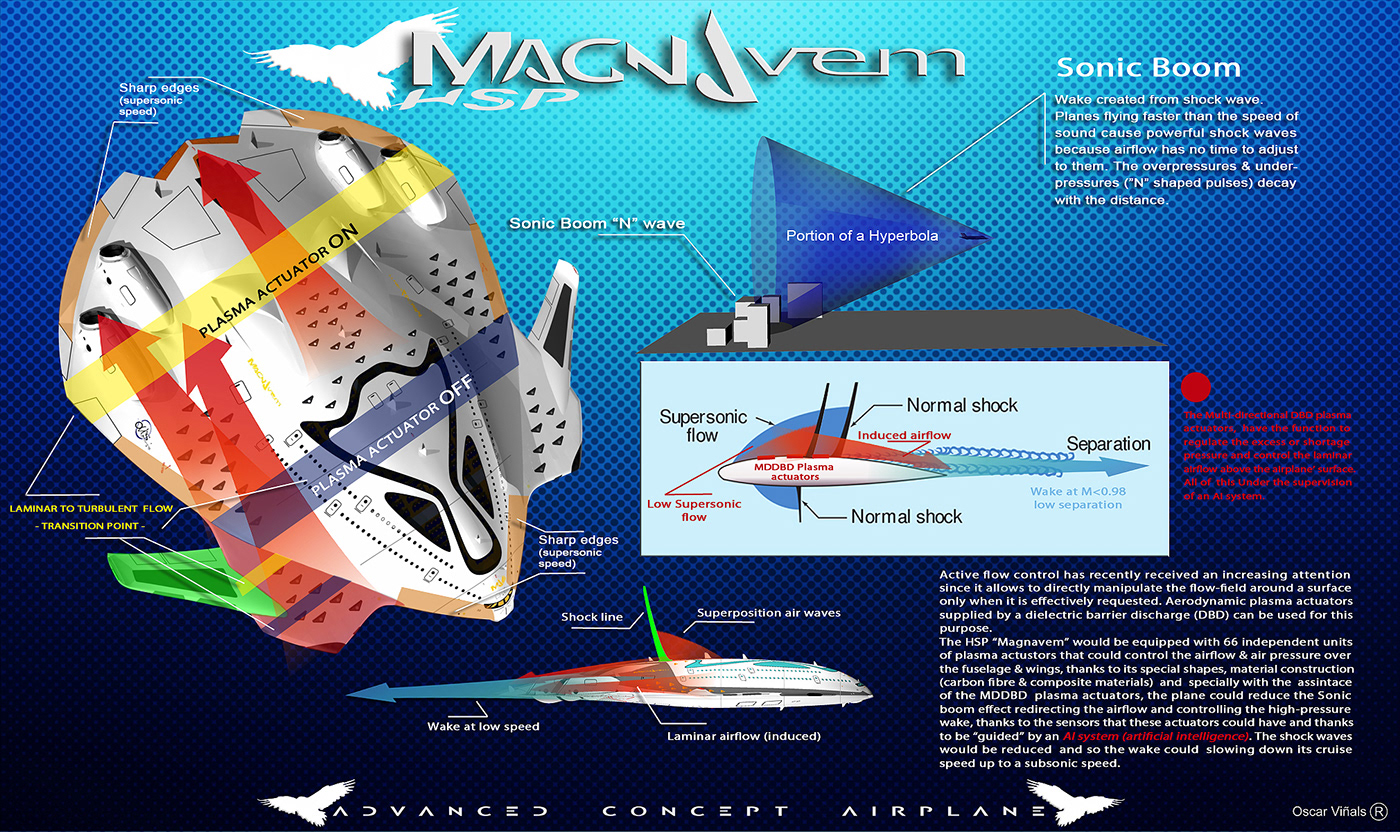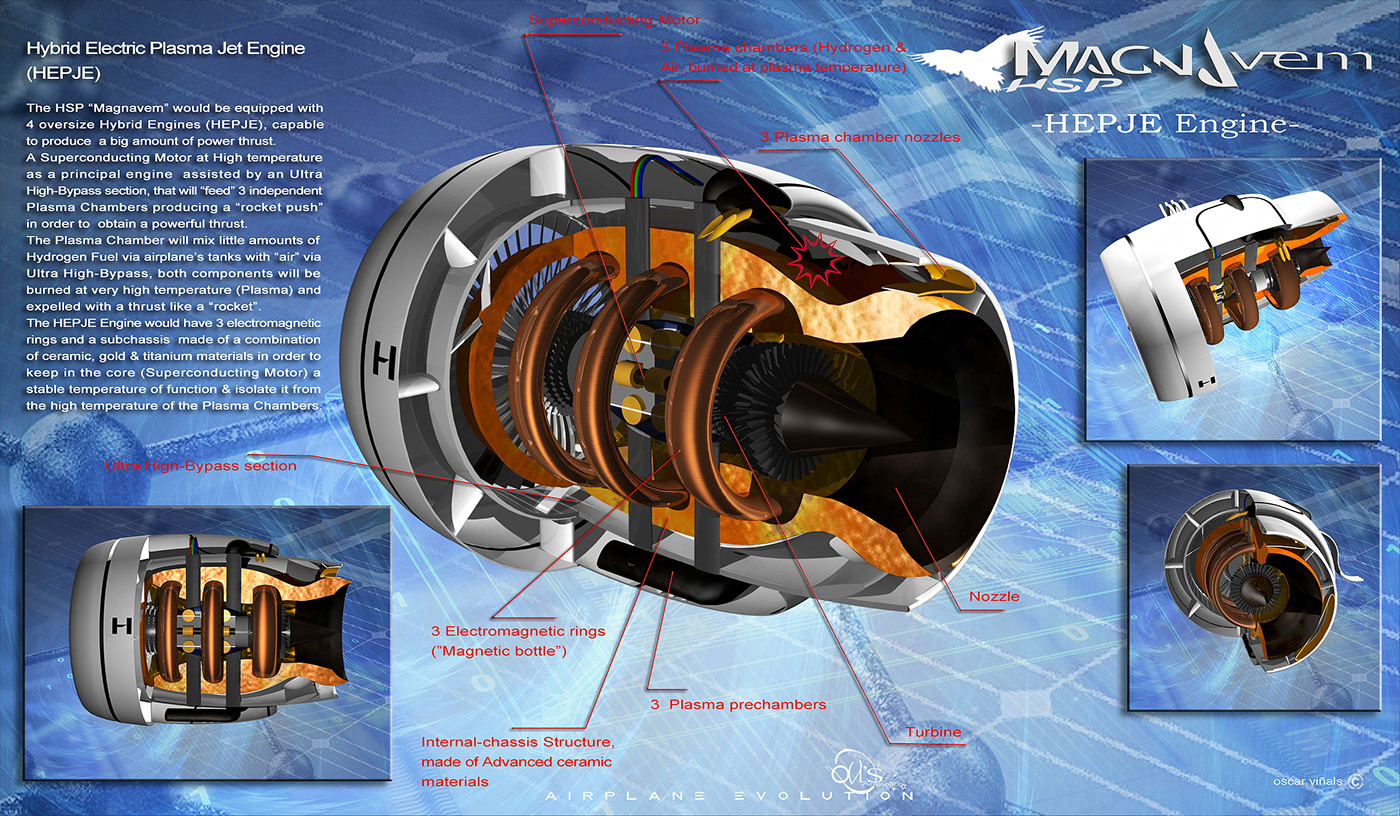HSP “Magnavem” a 4th state of matter plane
Now HSP Magnavem 3D model available, enjoy it!
https://www.turbosquid.com/FullPreview/Index.cfm/ID/1345263

NEW!, the AWWA Sky Whale 3D model available, enjoy it!
https://www.turbosquid.com/3d-models/awwa-sky-whale-concept-3d-1348887



Imagine we are in a century that we could define like “the great change”, it’s not sci-fi... this 21st Century we could find as “familiar” words and definitions like, Nuclear Fusion Reactor, AI systems (Artificial Intelligence), Plasma devices, Nano structures of Graphene, Supercapacitors, nanocomposites or Gallium Nitride semiconductors/power converters, and many more as it... is coming. This represents the beginning of a New Era on Aerospatiale & Aeronautic Industries.
In 10 to 15 years we could be at the beginning of discovering more about the fourth state of matter and its amazing qualities and properties, that will give us an infinite universe of possibilities to revolutionize our immediate future ..., new sources of inexhaustible energy and totally respectful with our environment, new materials that could make it possible to transform our daily lives, new uses or applications of this matter could help/assist us improving the performance of our today’s vehicles of transport (cars, trucks, airplanes, etc).
Based on these new and revolutionary expectations, the HSP “Magnavem” is born (Magna Avem – “Big Bird”), an Hyper Shape Plane (like today’s definition of “Hypercars”, that are the Top/Maximum definition of a car in all its best aspects) that “would fly to the encounter with the fourth state of matter”. The airplane would be itself a big wing with a delta’ shape and equipped with the best technology and solutions of this 21st Century.
Meet the HSP “Magnavem”:
As a principal power source, the HSP “Magnavem” will be equipped with a Compact Fusion Reactor (CFR-portable) that will power the Hybrid engines, electric airplane systems, CO2 cleaner system & to charge the airplane’s batteries.
The design of this fusion reactor could be based on the future Lockheed Martin’s concept, the “T4B”. Actually, there are some concerns about the viability of carrying up this solution on a plane. In 2014, Lockheed Martin announced that it was working on a compact fusion reactor that would be small enough to fit on the back of a truck. A later updated technical report, shows that Lockheed's fusion reactor is 100 times larger than originally planned, weighing a huge 2,000 tons and in terms of size, it is seven meters in diameter, and 18 meters long with a volume of ~16.3 cubic meter.
But, in my personal opinion in 10 to 15 years, it could change and we could reduce the size and the weight up to the point of making it feasible to equip an airplane with this technology. The application of the future materials, some of these underdeveloped today or in an early stage, like nano structures of graphene, superconductors ultra-lightweight at ambient temperature, magnetic monopole devices, new plasma’s accelerator systems will help to make it possible. This CFR could generate great amounts of electric energy with Zero Emissions.
In order to reach/achieve the highest flying performance, the airplane would be equipped by 206 MD-DBD Plasma actuators (Multi-directional Dielectric Barrier Discharge) that could control the airflow over the fuselage & wings, to maximize the performance at high (supersonic Mach 1.5) & low speed (subsonic), decreasing the airplanes drag, increasing the lift, controlling the air pressure, reducing the Reynolds number - Re - (micro turbulences) and also “dissipating” the Sonic boom. When the airplane would reach the Supersonic speed the effect that would produce the sonic boom would be mitigated, controlling the air pressure and the airflow over the fuselage & wings thanks to the MD-DBD actuators, the special airplane’ shape with sharp edges all around of it & materials, and also using an AI system that would control the transient of subsonic to supersonic speed.
Active flow control has recently received an increasing attention since it allows to directly manipulate the flow-field around a surface only when it is effectively requested. Aerodynamic plasma actuators supplied by a dielectric barrier discharge (DBD) can be used for this purpose. When the actuators are on (micro pulses), these would ionizes the air that surrounded the airplane given to it an “electric charge”, creating a visual effect like an Aurora Borealis but in order to keep save the passengers & the integrity of the airplane of possible high voltage dischargers from lightings, this would have 8 powerful lighting rods around the fuselage.
A "blue drop" in the skies


AWWA "Sky Whale" Scale model in the SHEIKH ABDULLAH AL SALEM CULTURAL CENTER (Kuwait)

















Thanks to two Ramjet Engines, the HSP “Magnavem” would fly at a maximum speed of Mach 1.5 (1,852 kph), these engines would turn on when the airplane would reach a speed of over 890 kph (Hybrid Engines) and an altitude of 15,400 m. These engines would be fueled by Hydrogen fuel (H2) and would have a vectoring nozzle system that would give it much more control & capacity of maneuver during the supersonic speed flight. The inlet diffuser of the Ramjet Engines would be located under the airplane’ fuselage.
The airplane would be equipped by an AI system (Artificial Intelligence) that would control and optimize the plasma actuators function, thanks to analyzing and processing all the data received from the actuators’ sensors (pressure, temperature, airflow speed, etc), from the nose of the airplane with the Micropulse coherent Doppler lidar system (could predict the wind turbulence strength in order to prevent “dangerous vibrations” that could affect the stability of the airplane. The aircraft could detect areas of turbulence including a new method that allows estimating the intensity of turbulence in the atmosphere at a distance in a clear sky) and with another source of data, like a 3d microwave radar that will report altitude, as well as azimuth and target distance, or inform about atmospheric situation in real time with 3d image.
Equipped with four oversize Hybrid Engines (Electric-Hydrogen fuel) in order to fly at subsonic speed and also to be very quiet, reducing the airplane noise up to minimum levels than current airplanes. These would be powered from battery storage or directly from the CFR, through the power converters made from Gallium Nitride and also fueled by Hydrogen (plasma chambers).
One of the most novel ideas/concepts of this plane would be the CO2 cleaner system, located on the rear part of it. This only would function in the approach maneuver and thanks to be powered by electric energy from the CFR (Compact Fusion Reactor), could split up the CO2 into carbon, hydrogen and oxygen with a thermoelectric process at very high temperature and water (air). The idea is not to “hijack” the CO2 from the atmosphere is split it in great amounts and release the result components on the atmosphere again.




























Vancouver International Airport Aerial photo by Alejandro Erickson



Equipped with Hybrid Wings & a Delta shaped fuselage, as well as sharp edges around it, in order to reach a Supersonic Speed & the best aerodynamic features. The Hybrid Wings would be composed by a combination of a laminar flow wing (similar to SNLF technology - supersonic natural laminar flow-) with plasma actuators and a conventional flow wing with smart technology (non mobile parts).
This airplane could take-off & land in approximately only eight hundred meters, thanks to its technologic & aerodynamics features.
It could have Two decks with a capacity for 500 passengers, a Super Tourist class with modular system that could accommodate between 280 to 360 seats with a generous “personal space” between them, a First class and Business class for 140 seats; with amazing views over their heads of the sky and all imaginable luxuries, like private suites, washrooms, spa, virtual reality, etc. The ceiling of the 2nd deck could be made of glass with nanotechnology capable to change its opacity (electrochromic) and act as solar cells (Quantum dots).Battery storage structure under of the fuselage made on nano structures of graphene with the proprieties to be ultra-lightweight, strong, ultra-fast charge & discharge. Six independent Hydrogen fuel tanks located under the airplane.
Rear extra landing gears.
Laser guidance system that would assist the airplane when the climatology is adverse. In order to guide the plane, analyzing the altitude, speed, position, angle of flight,… all the data for a right landing maneuver.
Fly at Supersonic Speed Mach 1.5 (1,852 kph). An altitude of cruise flight of 15,400 meters.
The approach & landing maneuver would be in a glide fly in order to save fuel, electric energy/power and in order to be super quite. All the Hybrid Engines would be in standby mode ready to star quickly in any time during this maneuver.All of these with the most important aspect of this advanced concept airplane, ZERO EMISSIONS.










Future airliners?













